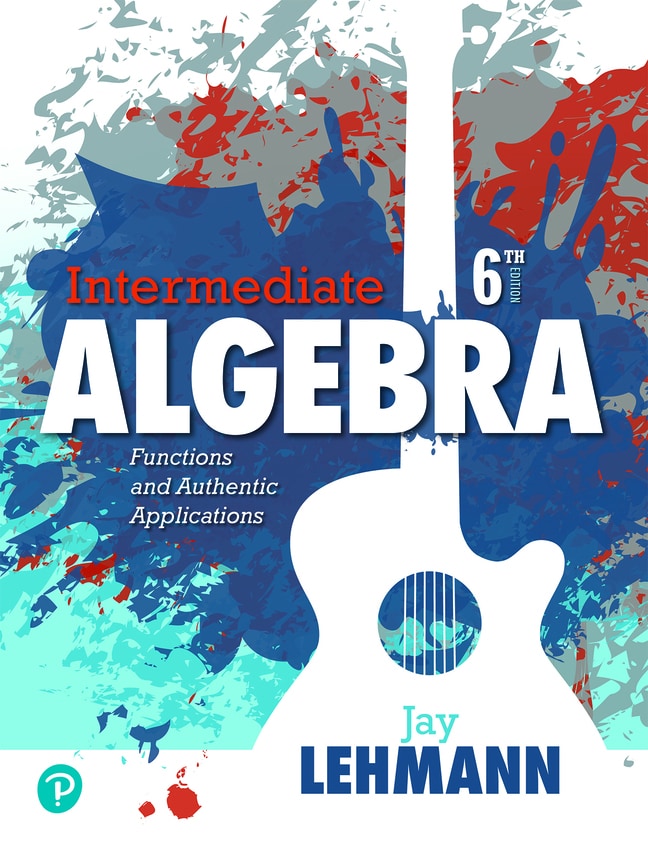
Intermediate Algebra: Functions and Authentic Applications, 6th edition
- Jay Lehmann

- Listen on the go
Learn how you like with full eTextbook audio
- Find it fast
Quickly navigate your eTextbook with search
- Stay organized
Access all your eTextbooks in one place
- Easily continue access
Keep learning with auto-renew
Are you looking for a new sound in algebra? Seeking to answer the perennial question “But what is this good for?” Intermediate Algebra models authentic data through curve-fitting to give new meaning to the math. It uses authentic, real-life data sets to find models and derive equations that fit the scenario. The curve-fitting approach teaches the mathematical concepts within the context of data, engaging you from the start and building conceptual understanding. The 6th Edition updates data sets throughout and offers new Large Data Set exercises to get you comfortable with analyzing big data. New downloadable data sets support the appropriate use of technology when completing exercises and labs. Throughout, even more resources are provided for you to practice, review and explore concepts.
Published by Pearson (July 14th 2021) - Copyright © 2019
ISBN-13: 9780137530465
Subject: Developmental Math
Category: Intermediate Algebra
- Linear Equations and Linear Functions
- 1.1 Using Qualitative Graphs to Describe Situations
- 1.2 Graphing Linear Equations
- 1.3 Slope of a Line
- 1.4 Meaning of Slope for Equations, Graphs, and Tables
- 1.5 Finding Linear Equations
- 1.6 Functions
- Modeling With Linear Functions
- 2.1 Using Lines to Model Data
- 2.2 Finding Equations of Linear Models
- 2.3 Function Notation and Making Predictions
- 2.4 Slope Is a Rate of Change
- Taking It to the Lab: Climate Change Lab • Used-Car Lab • Golf Ball Lab • Walking Student Lab • Linear Lab: Topic of Your Choice
- Systems of Linear Equations and Systems of Linear Inequalities
- 3.1 Using Graphs and Tables to Solve Systems
- 3.2 Using Substitution and Elimination to Solve Systems
- 3.3 Using Systems to Model Data
- 3.4 Value, Interest, and Mixture Problems
- 3.5 Using Linear Inequalities in One Variable to Make Predictions
- 3.6 Linear Inequalities in Two Variables; Systems of Linear Inequalities
- Taking It to the Lab: Climate Change Lab (continued from Chapter 2) • Sports Lab • Truck Lab
- Exponential Functions
- 4.1 Properties of Exponents
- 4.2 Rational Exponents
- 4.3 Graphing Exponential Functions
- 4.4 Finding Equations of Exponential Functions
- 4.5 Using Exponential Functions to Model Data
- Taking It to the Lab: Stringed Instrument Lab • Cooling Water Lab • Exponential Lab: Topic of Your Choice
- Logarithmic Functions
- 5.1 Composite Functions
- 5.2 Inverse Functions
- 5.3 Logarithmic Functions
- 5.4 Properties of Logarithms
- 5.5 Using the Power Property with Exponential Models to Make Predictions
- 5.6 More Properties of Logarithms
- 5.7 Natural Logarithm
- Taking It to the Lab: China and India Populations Lab • Folding Paper Lab • Exponential/Logarithmic Lab: Topic of Your Choice
- Polynomial Functions
- 6.1 Adding and Subtracting Polynomial Expressions and Functions
- 6.2 Multiplying Polynomial Expressions and Functions
- 6.3 Dividing Polynomials: Long Division and Synthetic Division
- 6.4 Factoring Trinomials of the Form x2 + bx + c; Factoring Out the GCF
- 6.5 Factoring Polynomials
- 6.6 Factoring Special Binomials; A Factoring Strategy
- 6.7 Using Factoring to Solve Polynomial Equations
- Taking It to the Lab: Climate Change Lab (continued from Chapter 3) • Projectile Lab
- Quadratic Functions
- 7.1 Graphing Quadratic Functions in Vertex Form
- 7.2 Graphing Quadratic Functions in Standard Form
- 7.3 Using the Square Root Property to Solve Quadratic Equations
- 7.4 Solving Quadratic Equations by Completing the Square
- 7.5 Using the Quadratic Formula to Solve Quadratic Equations
- 7.6 Solving Systems of Linear Equations in Three Variables; Finding Quadratic Functions
- 7.7 Finding Quadratic Models
- 7.8 Modeling with Quadratic Functions
- Taking It to the Lab: Climate Change Lab (continued from Chapter 6) • Projectile Lab (continued from Chapter 6) • Projectile Lab (Using a CBR or CBL) • Water Flow Lab • Quadratic Lab: Topic of Your Choice
- Rational Functions
- 8.1 Finding the Domains of Rational Functions and Simplifying Rational Expressions
- 8.2 Multiplying and Dividing Rational Expressions; Converting Units
- 8.3 Adding and Subtracting Rational Expressions
- 8.4 Simplifying Complex Rational Expressions
- 8.5 Solving Rational Equations
- 8.6 Modeling with Rational Functions
- 8.7 Variation
- Taking It to the Lab: Climate Change Lab (continued from Chapter 7) • Illumination Lab • Boyle’s Law Lab
- Radical Functions
- 9.1 Simplifying Radical Expressions
- 9.2 Adding, Subtracting, and Multiplying Radical Expressions
- 9.3 Rationalizing Denominators and Simplifying Quotients of Radical Expressions
- 9.4 Graphing and Combining Square Root Functions
- 9.5 Solving Radical Equations
- 9.6 Modeling with Square Root Functions
- Taking It to the Lab: Pendulum Lab
- Sequences and Series
- 10.1 Arithmetic Sequences
- 10.2 Geometric Sequences
- 10.3 Arithmetic Series
- 10.4 Geometric Series
- Taking It to the Lab: Bouncing Ball Lab • Stacked Cups Lab
- Additional Topics
- 11.1 Absolute Value: Equations and Inequalities
- 11.2 Performing Operations with Complex Numbers
- 11.3 Pythagorean Theorem, Distance Formula, and Circles
- 11.4 Ellipses and Hyperbolas
- 11.5 Solving Nonlinear Systems of Equations
APPENDICES
- A. Reviewing the Prerequisite Material
- B. Using a TI-83 or TI- 84 Graphing Calculator
- C. Using StatCrunch